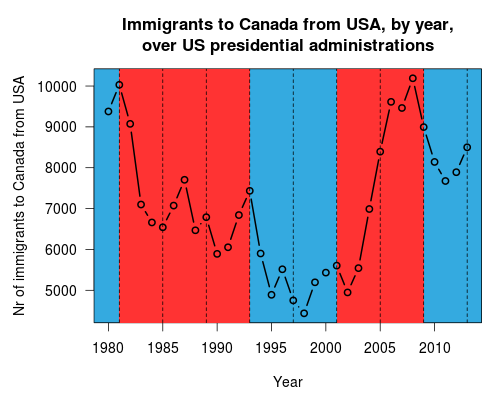Better late than never—here are my hazy memories of last semester. It was one of the tougher ones: an intense teaching experience, attempts to ratchet up research, and parenting a baby that’s still too young to entertain itself but old enough to get into trouble.
Previous posts: the 1st, 2nd, 3rd, and 4th semesters of my Statistics PhD program.
Classes
I’m past all the required coursework, so I only audited Topics in High Dimensional Statistics, taught by Alessandro Rinaldo as a pair of half-semester courses (36-788 and 36-789). “High-dimensional” here loosely means problems where you have more variables (p) than observations (n). For instance, in genetic or neuroscience datasets, you might have thousands of measurements each from only tens of patients. The theory here is different than in traditional statistics because you usually assume that p grows with n, so that getting more observations won’t reduce the problem to a traditional one.
This course focused on some of the theoretical tools (like concentration inequalities) and results (like minimax bounds) that are especially useful for studying properties of high-dimensional methods. Ale did a great job covering useful techniques and connecting the material from lecture to lecture.
In the final part of the course, students presented recent minimax-theory papers. It was useful to see my fellow students work through how these techniques are used in practice, as well as to get practice giving “chalk talks” without projected slides. I gave a talk too, preparing jointly with my classmate Lingxue Zhu (who is very knowledgeable, sharp, and always great to work with!) Ale’s feedback on my talk was that it was “very linear”—I hope that was a good thing? Easy to follow?
Also, as in every other stats class I’ve had here, we brought up the curse of dimensionality—meaning that, in high-dimensional data, very few points are likely to be near the joint mean. I saw a great practical example of this in a story about the US Air Force’s troubles designing fighter planes for the “average” pilot.
Teaching
I taught a data visualization course! Check out my course materials here. There’ll be a separate post reflecting on the whole experience. But the summer before, it was fun (and helpful) to binge-read all those dataviz books I’ve always meant to read.
I’ve been able to repurpose my lecture materials for a few short talks too. I was invited to present a one-lecture intro to data viz for Seth Wiener‘s linguistics students here at CMU, as well as for a seminar on Data Dashboard Design run by Matthew Ritter at my alma mater (Olin College). I also gave an intro to the Grammar of Graphics (the broader concept behind ggplot2) for our Pittsburgh useR Group.
Research
I’m officially working with Jing Lei, still looking at sparse PCA but also some other possible thesis topics. Jing is a great instructor, researcher, and collaborator working on many fascinating problems. (I also appreciate that he, too, has a young child and is understanding about the challenges of parenting.)
But I’m afraid I made very slow research progress this fall. A lot of my time went towards teaching the dataviz course, and plenty went to parenthood (see below), both of which will be reduced in the spring semester. I also wish I had some grad-student collaborators. I’m not part of a larger research group right now, so meetings are just between my advisor and me. Meetings with Jing are very productive, but in between it’d also be nice to hash out tough ideas together with a fellow student, without taking up an advisor’s time or stumbling around on my own.
Though it’s not quite the same, I started attending the Statistical Machine Learning Reading Group regularly. Following these talks is another good way to stretch my math muscles and keep up with recent literature.
Life
As a nice break from statistics, we got to see our friends Bryan Wright and Yuko Eguchi both defend their PhD dissertations in musicology. A defense in the humanities seems to be much more of a conversation involving the whole committee, vs. the lecture given by Statistics folks defending PhDs.
Besides home and school, I’ve been a well-intentioned but ineffective volunteer, trying to manage a few pro bono statistical projects. It turns out that virtual collaboration, managing a far-flung team of people who’ve never met face-to-face, is a serious challenge. I’ve tried reading up on advice but haven’t found any great tips—so please leave a comment if you know any good resources.
So far, I’ve learned that choosing the right volunteer team is important. Apparent enthusiasm (I’m eager to have a new project! or even eager for this particular project!) doesn’t seem to predict commitment or followup as well as apparent professionalism (whether or not I’m eager, I will stay organized and get s**t done).
Meanwhile, the baby is no longer in the “potted-plant stage” (when you can put him down and expect he’ll still be there a second later), but not yet in day care, while my wife is returning to part-time work. After this semester, we finally got off the wait-lists and into day care, but meanwhile it was much harder to juggle home and school commitments this semester.
However, he’s an amazing little guy, and it’s fun finally taking him to outings and playdates at the park and zoo and museums (where he stares at the floor instead of exhibits… except for the model railroad, which he really loved!) We also finally made it out to Kennywood, a gorgeous local amusement park, for their holiday light show.
Here’s to more exploration of Pittsburgh as the little guy keeps growing!
Next up
The 6th, 7th, 8th, 9th, and 10th semesters of my Statistics PhD program.



